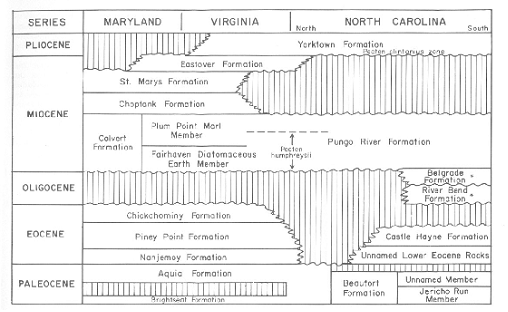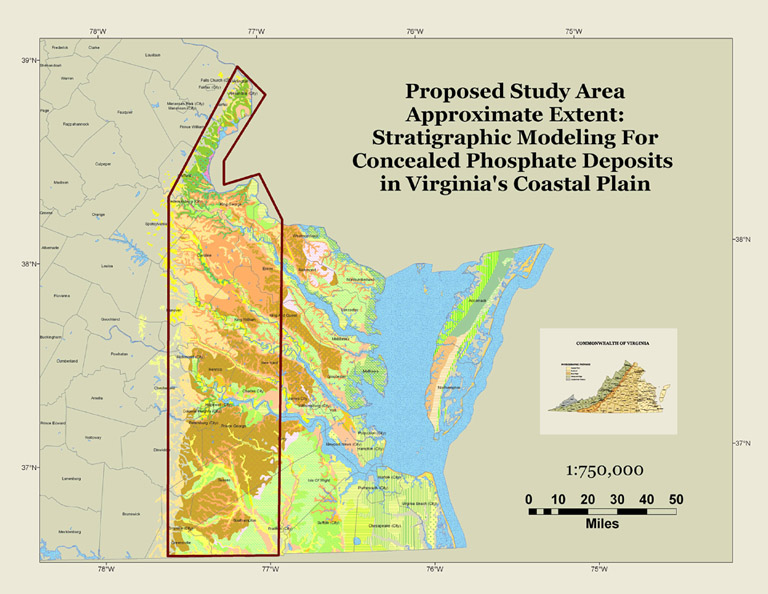
Phosphate fertilizer is one of the most important elements for plant growth
Phosphorus is a key element contained in all living cells and is thus an essential nutrient in the soil/plant/animal food cycle. As a vital component in commercial fertilizers and animal feed additives used in modern agriculture, phosphorus is obtained primarily from mined deposits of phosphate rock. Phosphorus compounds are also used in a wide variety of consumer products such as detergents, toothpaste, flame retardants in fabrics, and soft drinks. There are no known substitutes for phosphorus in biological systems and there are no significant commercial recycling processes. With projected increases in global population growth and food requirements, reliable supplies of phosphate rock will be a critical concern in the near future.
Phosphate rock in Virginia’s Coastal Plain
Production of phosphate rock in the U.S. has long been dominated by mines located in central Florida, although other important deposits are also currently mined in North Carolina, Idaho, and Utah. The deposits in Florida and North Carolina occur as sedimentary marine phosphorites that were deposited along the continental shelf and are recognized as part of a larger potential geologic resource along the Atlantic Coastal Plain. In North Carolina, phosphate rock is mined from sedimentary units within the Pungo River Formation, which was deposited in early to middle Miocene time (about 24 to 11 million years before present). In Virginia, this formation is equivalent to marine and marginal marine strata of the Chesapeake Group, which includes the Calvert Formation.

Stratigraphic correlation chart [modified from Ward and Blackwelder (1980); Gibson(1967)].
The Calvert Formation and other Neogene-age strata in Virginia’s Coastal Plain have been of interest in the past as a source of phosphate rock, yet there has never been a comprehensive assessment of the mineral potential.
Sedimentary formations in Virginia’s Coastal Plain are also known to host deposits of potash (potassium carbonate), rare earth elements (e.g. cerium, neodymium, etc.), and commercial heavy mineral deposits (e.g. titanium and zirconium oxides). The regional distribution and specific depositional environments of these mineral deposits remains poorly understood, and possibly under-explored.
Project Objectives
The aim of this project is to increase our knowledge of the stratigraphic and geochemical characteristics of sedimentary strata in Virginia’s Coastal Plain, with a focus on the potential for concealed phosphate rock resources. Other minerals of significant interest that will be investigated include potash, rare earth elements, and mineral sands enriched in titanium and zirconium. All of these minerals are known to occur in the Neogene-age sediments of Virginia’s Coastal Plain, some in economic deposits (e.g. Illuka Resources Inc., Old Hickory Mine).
The project will initially focus on a thirty-mile wide corridor along the western margin of the Virginia Coastal Plain, where formations of Miocene and Pliocene age either crop out or are situated at relatively shallow depths beneath the sedimentary cover. For this area, our scientists will:
- Examine existing well logs, cuttings, and cores for shows of mineral enrichment;
- Develop a three-dimensional stratigraphic model to understand the depositional environments and influence of key geologic structures;
- Target and drill new exploration boreholes using our truck-mounted auger, collecting samples for analysis;
- Evaluate the geochemical nature of collected rock samples, looking for evidence of mineral enrichment;
- Refine our understanding of the depositional environment as a predictor of phosphate ore.

Relevance and Impact
There is a substantial need to organize and re-evaluate existing data, identify and address critical information gaps, and revise existing models of phosphate deposition in the Atlantic Coastal Plain environment. Work conducted as part of this project will not only define the occurrence, quality, quantity, and environmental characteristics of concealed mineral resources, but also contribute to the general understanding of a broad range of coastal plain economic deposits. It is anticipated that the results of this project will provide the basis for new exploration interest by mineral producers in Virginia.
